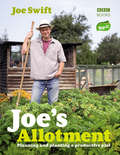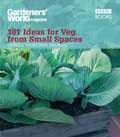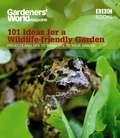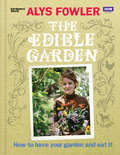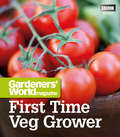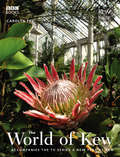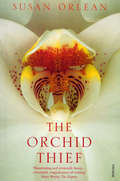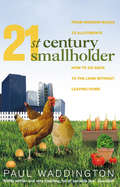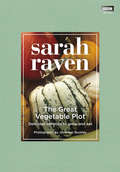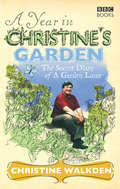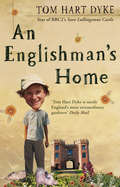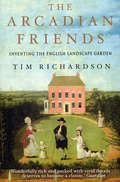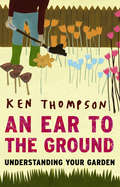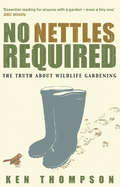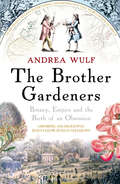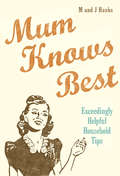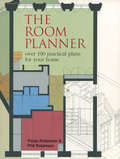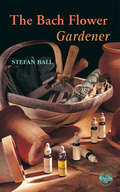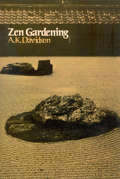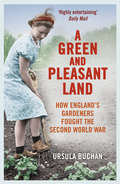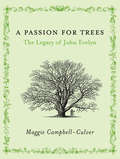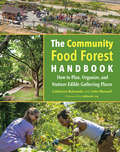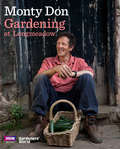- Table View
- List View
Joe's Allotment: Planning and planting a productive plot
by Joe SwiftWith hardly any previous veg-growing experience and even less time, when Gardener's World design guru Joe Swift decided to take on a 250 sq metre allotment in north London, some people thought he was mad. But with hard work and dedication, in less than a year Joe created his very own urban oasis and a source of delicious, fresh, organic produce for himself and his family.In this book Joe takes us through every stage of his education as an allotment gardener, from putting his name on the council waiting list to harvesting his first crops. He reveals everything he's learned about acquiring a plot, clearing the site, planning the beds, and planting, nurturing and protecting his fruit and vegetables. All the techniques he has mastered are described and illustrated, step by step.Joe also introduces us to his Veg Heroes like Monty Don and Geoff Hamilton - fellow plot-holders with years of experience and the crops to show for it - who inspired Joe to take up veg growing in the first place. And he shares with us his enjoyment of allotment gardening, the combination of hard work, fresh air and a sense of community that makes his plot such a special place to be.Whether you are an established allotment gardener or are thinking of putting your name down for a plot, Joe's Allotment will provide you with a wealth of advice and inspiration.
Gardeners' World: 101 Ideas For Veg From Small Spaces
by Jane MooreWhat can be more convenient than being able to nip into the garden to pick some salad for lunch, some herbs for the pot or some fresh veg or fruit for dinner? Nothing beats the flavour of home-grown produce, or, in these days of additives and preservatives, the reassurance of knowing what is in your food. Contrary to popular belief, you don't need an enormous garden, or a dedicated spot within it to grow your own, nor do you need to join the mammoth waiting lists for a local allotment; all you need is a window ledge, some steps, a patio, some wall space or even some gaps in your flower borders.In this handy book the team at Gardeners' World Magazine will give you loads of tips on how to get started if you've never grown fruit or vegetables before, suggest some fun and practical ways you can grow your favourite crops in a limited space or small garden, and tell you how to get the best from what you grow. Growing your own has never been more popular or more simple, and in this essential little guide, packed with inspirational ideas and advice from Gardeners' World Magazine, everyone can get in on the act. So what's stopping you now? Go on, grow your own grub!
Gardeners' World: 101 Ideas For A Wildlife-friendly Garden
by Mick LavelleIf you yearn to watch blackbirds feeding their young, and butterflies flitting amongst the flowers but you don't have the space for a meadow or want to give your whole garden over to nature, don't despair: with just a few clever tricks you can bring the countryside and its residents to your garden, even in the most urban of locations. Encouraging a little wildlife into your garden can bring a lot of benefits for the gardener. Having a wildlife-friendly garden isn't just about letting nature do its thing so that you can enjoy watching it from your window or the patio, it has a far more important contribution to make. Let nature do the hard work of gardening for you: ladybirds and blue tits will make short work of aphids, while birds, bats and hedgehogs will feast on larger insects. It's biological control at its best; leaving you more time to sit in your deck chair and listen to the dawn chorus of the birds, the croaking of frogs, and the nighttime grunting of visiting hedgehogs. If the natural look of a wildlife garden isn't your thing, you'll be pleased to know that even the most modern, minimalist garden can include features which will bring in wildlife without cramping your style. In this book, the team at Gardeners' World Magazine bring you tips and advice on simple ways in which you can create a haven for wildlife - whatever your garden style.
The Edible Garden: How to Have Your Garden and Eat It
by Alys FowlerIn this timely book, Gardeners' World's thrifty and resourceful Alys Fowler shows that there is a way to take the good life and re-fashion it to fit in with life in the city. Abandoning the limitations of traditional gardening methods, she has created a beautifully productive garden where tomatoes sit happily next to roses, carrots are woven between the lavenders and potatoes grow in pots on the patio. And all of this is produced in a way that mimics natural systems, producing delicious homegrown food for her table. And she shares her favourite recipes for the hearty dishes, pickles and jams she makes to use up her bountiful harvest, proving that no-one need go hungry on her grow-your-own regime. Good for the pocket, good for the environment and hugely rewarding for the soul, The Edible Garden urges urbanites everywhere to chuck out the old gardening rules and create their own haven that's as good to look at as it is to eat.
Gardeners' World: First Time Veg Grower
by Martyn CoxWhen it comes to fresh vegetables, nothing comes close to growing your own - but where to start? For those of us that crave the crisp taste of home-grown tomatoes, peppers, courgettes and more but lack the crucial experience and know-how, it can be difficult to make those first steps to transform a barren patch into a luscious kitchen garden - even for experienced gardeners, the move from decorative gardening to practical vegetable growing can prove tricky.Gardeners' World: First Time Veg Grower can help you make that journey, with simple and practical expert advice from the moment you first don your wellies right up until you're harvesting your own crops. With step-by-step guides and clear colour illustrations helping you to get the most out of your plot all year round, this compact guide is an essential addition to any gardener's shelf. From preparing your ground to sowing, nurturing and maintaining your plants, let the practiced hands at the UK's best-selling gardening magazine help you create the vegetable patch of your dreams.
The World of Kew
by Carolyn FryWithout plants, there would be no life on earth. Kew Gardens is famous for its breathtaking displays of flowers and tree,s but this World Heritage Site is also a globally important scientific and historical organization. Scientists and gardeners use the plants and knowledge that have been collected at Kew since the eighteenth century to advance understanding of the earth's environment and of how plant lfe can be used for human benefit. Published to accompany the ten-part BBC2 series A New Year at Kew, this fascinating book takes us behind the scenes to show the extraordinary range of work carried out at Kew Gardens and Wakehurst Place - home to the Millenium Seed Bank - and by Kew staff overseas. From using forensic botant to micropagating plants facing extinction, from investigating herbal cures from Alzheimer's disease to replanting the volcano-ravaged island of Montserrat, the book shows us aspects of Kew's work that are largely hidden from view abut the benefits of which are far reachingl In the process it provides an absorbing and accessible introduction to such topical subjects as biodiversity, practical conservation and economic botany. Lavishly illustrated and filled with engrossing stories and engaging characters, this book brings to life the world of Kew and the global importance of its work.
The Orchid Thief: A True Story Of Beauty And Obsession
by Susan OrleanSusan Orlean first met John Laroche when visiting Florida to write for the New Yorker about his arrest for stealing rare ghost orchids from a nature reserve. Fascinated both by Laroche and the world she uncovered of orchid collectors and growers, she stayed on, to write this magical exploration of obsession and the strange world both of the orchid obsessives and of Florida, that haunting and weird 'debatable land' of swamps and condos, retirement communities and real-estate scams. The world of the orchid hunters, breeders and showmen, their rivalries, vendettas and crimes, smuggling, thefts and worse provide the backdrop to a fascinating exploration of one of the byways of human nature, the obsessive world of the collector, and the haunting beauty of the flowers themselves.
21st-Century Smallholder: From Window Boxes To Allotments: How To Go Back To The Land Without Leaving Home
by Paul WaddingtonAchieving genuine self-sufficiency of the kind described in John Seymour's classic guide is sadly beyond the vast reach of the urban majority today. Few have the space, and for those few there are comprehensive guidebooks. But where do the rest of us look for the answers to questions like how much effort does it really take to grow your own food? Is beekeeping difficult? Is solar power really worth the bother?From a small terraced house in the middle of a big city, Paul Waddington has made it his business to find out, and while trying it himself, has created a practical and absorbing guidebook along the way. It includes easy-to-read lists, tables, personal anecdote, and stunning illustrations, and more importantly demystifies the subject with practical tips that get to the heart of the matter to show you how you can enjoy the fulfilling aspects of the smallholding life without the hassle and expense of 'going all the way'. If you want to go back to the land without leaving home, this is the perfect guide.
The Great Vegetable Plot: Delicious Varieties To Grow And Eat
by Jonathan Buckley Sarah Raven'A vegetable plot is a beautiful thing to make, with the extra bonus of producing the best possible things to eat. If you get it right, the whole place can become your market, your haven and your playground.'So says Sarah Raven in The Great Vegetable Plot, an indispensable practical guide to creating the perfect vegetable garden with the minimum of fuss and effort. By eschewing the timely and unnecessary steps that can frustrate even the most patient gardener, Sarah's principles of speed and simplicity can help you to craft a plot that perfectly suits your needs - and lets you enjoy fresh, home-grown crops all year round.Sarah's straight-forward approach focuses on easy and rewarding vegetables that don't require huge amounts of time or space, meaning you don't need to devout hours to slavishly tending your plot. Beautifully illustrated with over 250 photographs from award-winning photographer Jonathan Buckley, this inspiring guide is ultimately all about pleasure - from the enjoyment you'll get from planting and growing your own produce to the priceless reward of having a wealth of fresh vegetables just outside your door.
A Year in Christine's Garden: The Secret Diary Of A Garden Lover
by Christine WalkdenA Year in Christine's Garden is the utterly down-to-earth account of one woman's passion for plants. Recounting stories from her hectic life in horticulture, Christine Walkden's diary is a heartwarming account of octogenarian neighbours, living with a film crew and helping friends with their gardening needs. Reflecting all the charm of her BBC2 television series, Christine's narrative paints a picture of the day-to-day beauty that surrounds her. She likes being outside, she likes walking her dog Tara, she likes watching the light change and she enjoys those little moments when everything seems right in the world.With irrepressible enthusiasm, she interweaves tips and advice to prove that the best gardens are approachable and achievable. Forget fashion, forget trends - Christine's garden is about no-nonsense planting and growing what you enjoy. As the year progresses, this warm, but frank diary brings to life all the moments of pride, excitement, relaxation and laugh-out-loud fun that make Christine's garden a haven of contentment.
An Englishman's Home: The Adventures Of An Eccentric Gardener
by Tom Hart DykeTom Hart Dyke has a bit of a thing about plants. You might call it an obsession. You might call him certifiable, in fact. But it's a truth universally acknowledged that a single man in possession of a large ramshackle country estate and an obsession with plant collecting could want for only one thing - in Tom's case it's a walled garden containing examples of plants collected from every corner of the globe.Tom's infectious enthusiasm for anything with chlorophyll in it and the hugely ambitious World Garden project he has undertaken at his family home, Lullingstone Castle, in Kent have been documented in a 12-part television series for BBC 2. The first six parts (Save Lullingstone Castle) were shown in spring 2006, and the second six episodes (Return to Lullingstone Castle) in spring 2007 to coincide with hardback publication. Tom's attempts to set up the World Garden aren't exactly straightforward. You might imagine, for example, that the easiest way to start preparing the ground inside the walled Elizabethan garden which he transforms into the main part of the world garden would be to enlist the help of a few people and a lot of hard digging. Well not for Tom, who enlists instead two large pigs, who do indeed do a great job of turning over the earth and fertilising it with great organic manure. But the problem is that they keep escaping into the Hart Dyke family burial plot next door where they start digging up Tom's ancestors...The World Garden is created to bring together a truly amazing collection of plants from every continent and so to show the global origins of the plants we all grow in our gardens. It's already establishing itself as a tourist attraction of some note as well as an educational resource. This is a book for all those who bought Tim Smit's Lost Gardens of Heligan. It's stuffed full of fascinating botanical information as well as the story of Tom's hapless struggle to overcome huge logistical nightmares. It's a riveting, hilarious story of English eccentricity in full bloom.
The Arcadian Friends
by Tim RichardsonBetween 1715 and 1750, a group of politicans and poets, farmers and businessmen, heiresses and landowners began to experiment with the phenomenon that was to become the English landscape garden. Arguably the greatest British art form ever invented, these gardens were built to charm and delight, to shock and inspire all who visited. That these gardens - including Castle Howard, Stowe, Painshill and Rousham - are still so popular with visitors today is a testament to the innovation and passion of this extraordinary group of eccentrics and visionaries.The Arcadian Friends takes a highly engaging perspective on the politics and culture of England during the Enlightenment. At the same time it will be required reading for the legions of fans of the great gardens of England.Tim Richardson introduces us to a period of poltical and personal intrigue, where fantastic biblical landscapes competed for space with temples to sexual freedom; and where the installation of a water feature was a political act. The Arcadian Friends tells the story of a collection of fascinating characters whose influence changed the landscape of Britain for ever.
An Ear To The Ground: Understanding Your Garden
by Ken ThompsonHow did plants get to be the way they are? Why do they have pretty flowers? How different would things have been if the wrong kind of pollinators had got the upper hand? Why are Latin names so complicated, and why Latin anyway? Why is a weed-free lawn an ecological impossibility?This entertaining book gives the answers to these questions and many more. It shows how a little botanical knowledge can bring not just better results but peace of mind, and that losing sleep over such traditional gardening bogeys as weeds, pests and pruning is not necessarily the best course. In this new edition Ken Thompson grabs the opportunity to explain why any old plant will do for companion planting - but also that it can do as much harm as good - and why planting by the moon is complete and utter nonsense.
No Nettles Required: The Reassuring Truth About Wildlife Gardening
by Ken ThompsonIn 2003 a MORI poll for the Royal Horticultural Society revealed that an extraordinary number of us are interested in attracting wildlife into our gardens. It also indicated, however, that many of us have no idea how to go about it. Information is sparse, and public opinion seems to suggest that gardens that are plentiful in wildlife are unattractive, expensive to upkeep and hard work to maintain. But this couldn't be further from the truth.In this illuminating book, Ken Thompson explains that encouraging wildlife is actually entirely compatible with ordinary gardening, costs next to nothing and is almost completely effortless. Packed with helpful hints and tips, the book shows us how easy it is to fill our gardens with everything from foxes, frogs and mice to butterflies, ladybirds and literally thousands of fascinating creepy-crawlies. Why should we? Because we'll be promoting the biodiversity of the UK, we'll be reconnecting with nature, getting more from our gardens, and we'll be doing our plants a favour.
The Brother Gardeners: Botany, Empire and the Birth of an Obsession
by Andrea WulfOne January morning in 1734, cloth merchant Peter Collinson hurried down to the docks at London's Custom House to collect cargo just arrived from John Bartram in the American colonies. But it was not bales of cotton that awaited him, but plants and seeds...Over the next forty years, Bartram would send hundreds of American species to England, where Collinson was one of a handful of men who would foster a national obsession and change the gardens of Britain forever: Philip Miller, author of the bestselling Gardeners Dictionary; the Swede Carl Linnaeus, whose standardised botanical nomenclature popularised botany; the botanist-adventurer Joseph Banks and his colleague Daniel Solander who both explored the strange flora of Tahiti and Australia on Captain Cook's Endeavour.This is the story of these men - friends, rivals, enemies, united by a passion for plants. Set against the backdrop of the emerging empire and the uncharted world beyond, The Brother Gardeners tells the story how Britain became a nation of gardeners.
Mum Knows Best: Exceedingly Helpful Household Tips
by Jo Hanks Mark HanksHow to you save a curdled custard?How do you keep mice out of the home?How do you stop moths eating your woollens?How do you get chewing gum out of a five-year-old's hair?Or get rid of his veruccas?And cure hiccoughs in a trice?The answers to all these every day dilemmas, and many, many more, are at hand in this nifty little encyclopaedia of essential things every mum needs to know.
The Room Planner: Over 100 practical plans for your home
by Paula Robinson Phil RobinsonMost of us want to improve our homes and to increase their value at the same time, but very few of us have the money to spend on a professional architect. In Room Planner designer Paula Robinson gives you all the ideas and practical information you need to adapt the space in which you live. The book features over 100 clear, colour-coded plans allowing you to pick and choose layouts and designs according to what's appropriate for your home, whether you have a bedsit or a five-bedroom house. To reflect changing lifestyles, the emphasis is very much on versatility and flexibility, with chapters on High-performance space (making maximum use of available space), Valuable space (dividing space to create additional rooms and increase property value), Flexible space (creating moveable partitions) and Individual space (innovative solutions for particular rooms). There's also basic advice and tips, including: Using colour in the home: blue helps to focus the mind and intellect; green has harmonious, soothing effects; yellow stimulates and invigorates; orange stimulates the appetite.Using shapes: the kidney shape brings a softness and flexibility to interiors; circles introduce a sense of freedom and space.Creating atmosphere: an inset fire set higher up in the wall can have a stunning effect; backlit cupboard doors draw the eye; concealed lighting introduces mood and atmosphere while creating a sense of depth; mirroring the wall opposite the entrance door can bring life and character to a property.This is an essential manual not only for homeowners seeking to rethink their living space, but also for those who are building their home from scratch. Paula and Phil's guide will inspire in you the confidence and enthusiasm to maximise the potential of your living space, so that you too can create your dream home.
Remaking Housing Policy: An International Study
by David ClaphamBreaking the country-specific boundaries of traditional housing policy books, Remaking Housing Policy is the first introductory housing policy textbook designed to be used by students all around the world. Starting from first principles, readers are guided through the objectives behind government housing policy interventions, the tools and mechanisms deployed and the outcomes of the policy decisions. A range of international case studies from Europe, Asia, Africa and the Americas illustrate the book’s general principles and demonstrate how different regimes influence policy. The rise of the neo-classical discourse of market primacy in housing has left many countries with an inappropriate mix of state and market processes with major interventions that do not achieve what they were intended to do. Remaking Housing Policy goes back to basics to show what works and what doesn’t and how policy can be improved for the future. Remaking Housing Policy provides readers with a comprehensive introduction to the objectives and mechanisms of social housing. This innovative international textbook will be suitable for academics, housing students and those on related courses across geography, planning, property and urban studies.
The Bach Flower Gardener
by Stefan BallPeople all over the world know of the system of 38 flower remedies discovered by Dr.Bach. It is a system so gentle that remedies can be given even to new-born babies with perfect safety. It does not react with other medicines, so that therapists who specialize in other treatments often use it as a complement to their main techniques. Its focus on the emotions makes it a natural partner to the more physically- orientated approaches of most orthodox and non-orthodox medical traditions. And above all it is effective - which is why the use of this system has spread via personal recommendation and word of mouth from one small corner of Oxfordshire to more than 66 countries around the world.It is somewhat less well known that the remedies can be used just as effectively to help plants.Drawing on the experiences of practitioners and correspondents from around the world the author shows just how the remedies can raise the vibrations of plants with the most wonderful results. Readers will come to see the remedies as vital aids to holistic gardening - as essential as any mulch or compost.
Perfect Money Saving (The\perfect Ser.)
by Smita Talati- Do you find you're always strapped for cash at the end of the month?- Are you worried about paying your credit card bills?- Would you like some practical advice on how to make your money go further?Perfect Money Saving is the essential guide for anyone who wants to take control of their finances. Covering everything from home-made presents to cheaper mortgages, it gives step-by-step guidance on how to cut your costs without giving up the things you enjoy. With sections on debt management and your financial portfolio, as well as a month-by-month breakdown showing where and when to grab the best bargains, Perfect Money Saving has all you need to make the most of every penny.The Perfect series is a range of practical guides that give clear and straightforward advice on everything from getting your first job to choosing your baby's name. Written by experienced authors offering tried-and-tested tips, each book contains all you need to get it right first time.
Zen Gardening: Muso Soseki In His Gardens (Michigan Monograph Series In Japanese Studies #56)
by A. K. DavidsonThe Zen gardens of Japan are places in which to meditate. They can be anything from a landscaped garden, complete with waterfalls, to a bed of raked pebbles. This ancient way of gardening goes back to the Zen Buddhist priest-gardeners of the thirteenth century. Based on abstract compositions, relying on simplicity and suggestion, their gardens were designed to liberate the imagination, while providing a starting point in the appreciation of everyday things.Zen Gardening is the first handbook to examine the concepts and techniques that make up this garden art and to apply them to the West. It explains the historical relationship between Zen and the development of gardens, and gives practical suggestions for the creation of a Zen garden at home. The chapters on the garden components and their adaptation for the West, principles of design, and construction work, are illustrated with over 150 line drawings. Step by step they show us how to make the most of corners of large gardens, of plots not large enough for lawns and flower beds, or of awkward passageways, alleys and terraces.The principles of Zen gardening are particularly relevant in our crowded conurbations. Keir Davidson's thoughtful and practical approach enables us to maximize our garden space and to create areas of calm in our own immediate environment. Without precedent in the West, his book will be a source of delight to gardeners of every persuasion.
A Green and Pleasant Land: How England’s Gardeners Fought the Second World War
by Ursula BuchanSHORTLISTED FOR INSPIRATIONAL BOOK OF THE YEAR AT THE 2014 GARDEN MEDIA GUILD AWARDS. The wonderfully evocative story of how Britain’s World War Two gardeners – with great ingenuity, invincible good humour and extraordinary fortitude – dug for victory on home turf.A Green and Pleasant Land tells the intriguing and inspiring story of how Britain's wartime government encouraged and cajoled its citizens to grow their own fruit and vegetables. As the Second World War began in earnest and a whole nation listened to wireless broadcasts, dug holes for Anderson shelters, counted their coupons and made do and mended, so too were they instructed to ‘Dig for Victory’. Ordinary people, as well as gardening experts, rose to the challenge: gardens, scrubland, allotments and even public parks were soon helping to feed a nation deprived of fresh produce. As Ursula Buchan reveals, this practical contribution to the Home Front was tackled with thrifty ingenuity, grumbling humour and extraordinary fortitude. The simple act of turning over soil and tending new plants became important psychologically for a population under constant threat of bombing and even invasion. Gardening reminded people that their country and its more innocent and insular pursuits were worth fighting for. Gardening in wartime Britain was a part of the fight for freedom.
A Passion For Trees: The Legacy Of John Evelyn
by Maggie Campbell-CulverGiven the extent of his influence on 17th-century life, and his lasting impact on the British landscape it is remarkable that no book has been written before about John Evelyn. He was a longstanding friend of Samuel Pepys (who wrote of him, ' A most excellent person he is, and must be allowed a little for conceitedness; but he may well be so, being a man so much above others.'), a founder-member of the Royal Society and a prolific writer and diarist. He was an early advocate of the garden city but his most important work was Sylva: a Discourse of Forest Trees. Sylva was presented to the Royal Society to promote the planting of timber trees 'for the supply of the Navy, the employment and advantage of the poor as well as the ornamenting of the nation.' He was responsible for the first great raft of tree-planting and for a great influx of tree introductions to Britain.Maggie Campbell-Culver's book, like Sylva, has at its core a section detailing the characteristics, history and uses of 33 trees incorporating the advice Evelyn gave and demonstrating its relevance still in the 20th-century. Not only was Evelyn probably the first horticultural writer to show an appreciation of the aesthetic benefits of trees in our landscape, he is shown to be a founder-father of the modern conservation movement.
The Community Food Forest Handbook: How to Plan, Organize, and Nurture Edible Gathering Places
by Catherine Bukowski John Munsell LaManda JoyCollaboration and leadership strategies for long-term success Fueled by the popularity of permaculture and agroecology, community food forests are capturing the imaginations of people in neighborhoods, towns, and cities across the United States. Along with community gardens and farmers markets, community food forests are an avenue toward creating access to nutritious food and promoting environmental sustainability where we live. Interest in installing them in public spaces is on the rise. People are the most vital component of community food forests, but while we know more than ever about how to design food forests, the ways in which to best organize and lead groups of people involved with these projects has received relatively little attention. In The Community Food Forest Handbook, Catherine Bukowski and John Munsell dive into the civic aspects of community food forests, drawing on observations, group meetings, and interviews at over 20 projects across the country and their own experience creating and managing a food forest. They combine the stories and strategies gathered during their research with concepts of community development and project management to outline steps for creating lasting public food forests that positively impact communities. Rather than rehash food forest design, which classic books such as Forest Gardening and Edible Forest Gardens address in great detail, The Community Food Forest Handbook uses systems thinking and draws on social change theory to focus on how to work with diverse groups of people when conceiving of, designing, and implementing a community food forest. To find practical ground, the authors use management phases to highlight the ebb and flow of community capitals from a project’s inception to its completion. They also explore examples of positive feedbacks that are often unexpected but offer avenues for enhancing the success of a community food forest. The Community Food Forest Handbook provides readers with helpful ideas for building and sustaining momentum, working with diverse public and private stakeholders, integrating assorted civic interests and visions within one project, creating safe and attractive sites, navigating community policies, positively affecting public perception, and managing site evolution and adaptation. Its concepts and examples showcase the complexities of community food forests, highlighting the human resilience of those who learn and experience what is possible when they collaborate on a shared vision for their community.
Gardening at Longmeadow
by Monty DonMonty Don made a triumphant return to our screens as presenter of Gardeners' World. A firm favourite with viewers, Monty's infectious enthusiasm for plants, attention to the finer details of gardening technique and easy charm have seen the ratings soar. Here Monty invites us into the garden at Longmeadow, to show us how he created this beautiful garden, and how we can do the same in our own.Following the cycle of the seasons, Gardening at Longmeadow will introduce readers to the garden from the earliest snowdrops of January through the first splashes of colour in the Spring Garden, the electric summer displays of the Jewel Garden, the autumn harvest in the orchard, and on to a Christmas feast sourced from the vegetable gardens. Describing the magic of each area at different times of the year, Monty will explain the basics of what to do when and how to get the most from each plant. He'll talk through the essential techniques and more complex processes, accompanied by easy-to-follow, step-by-step photography.Longmeadow is a gardeners' garden, but this will be a book for gardening enthusiasts of all skill levels who have been inspired by what they've seen, and who would like to achieve something similar for themselves.
